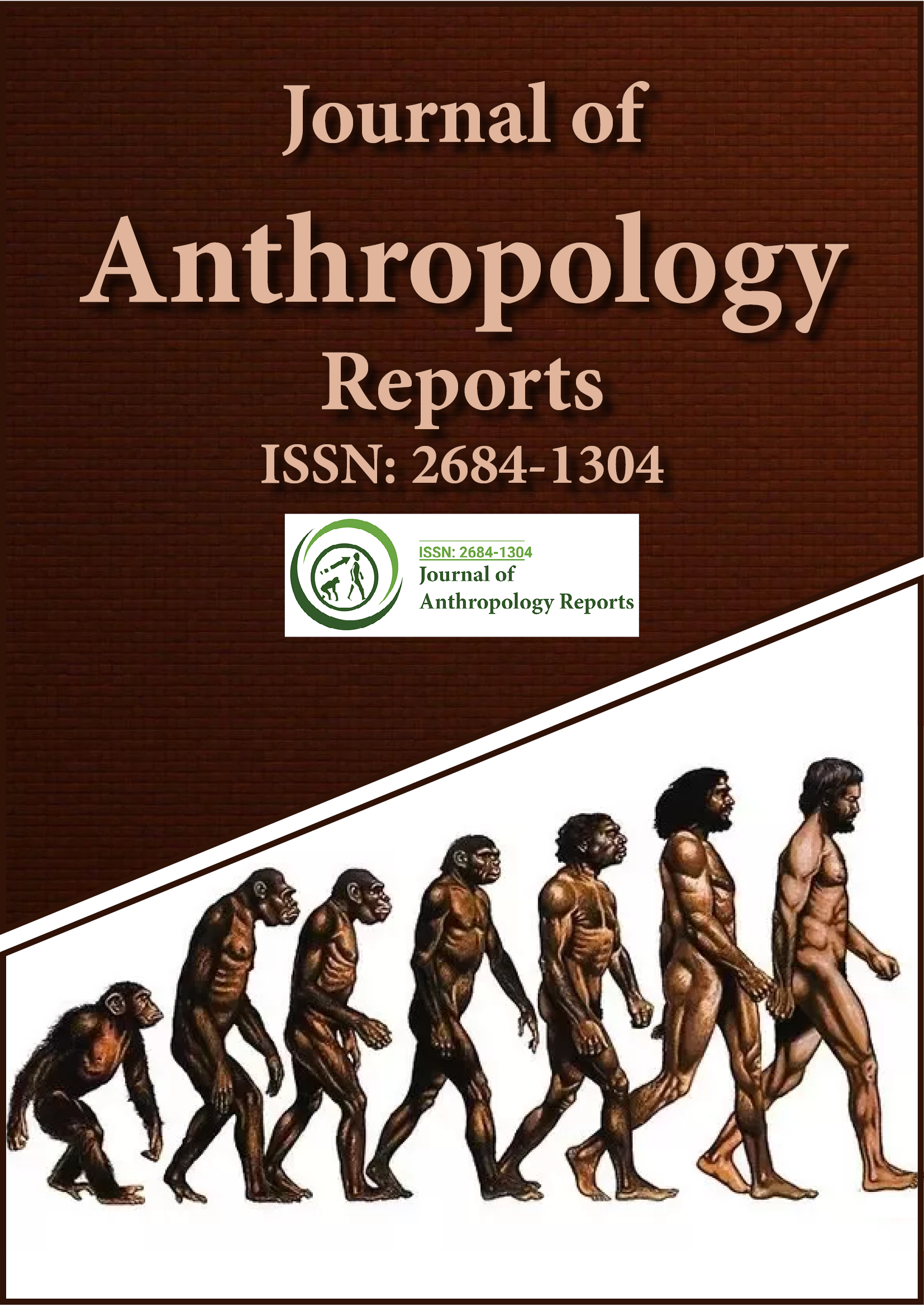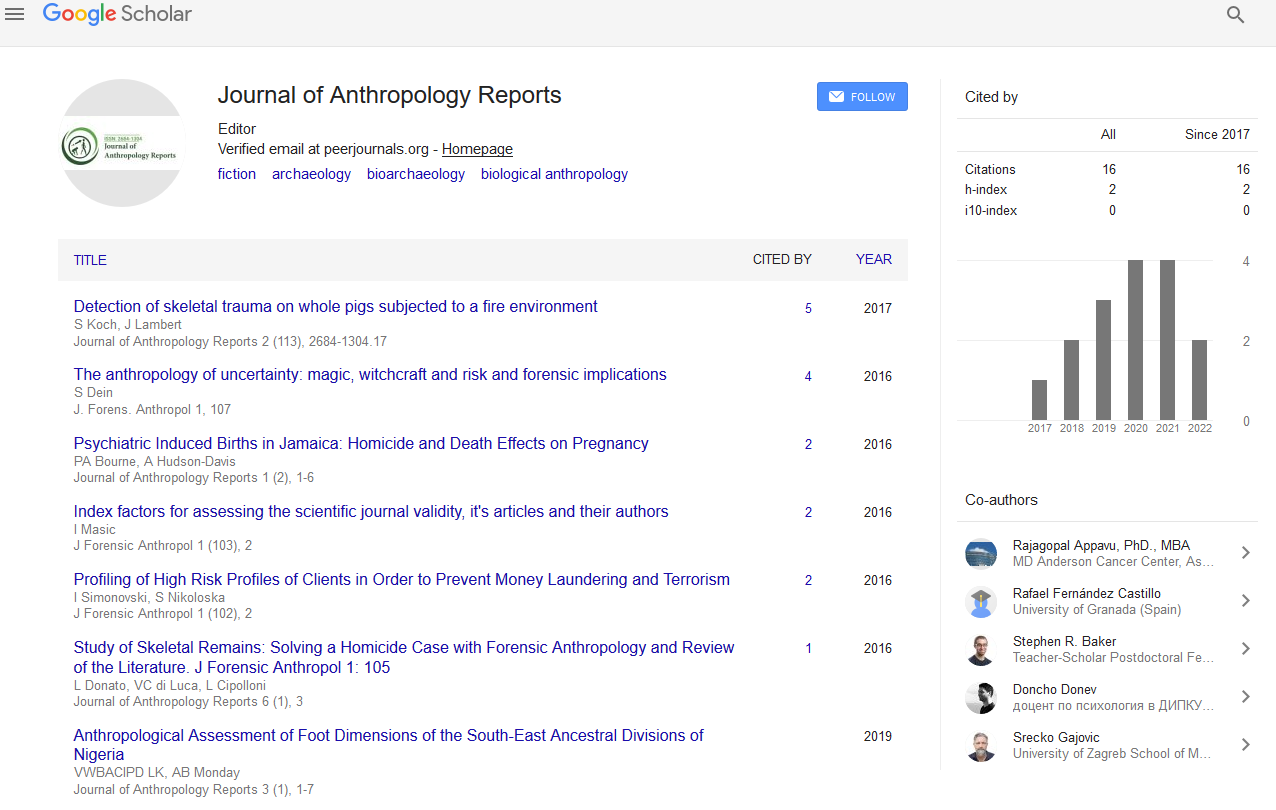Indexed In
- RefSeek
- Hamdard University
- EBSCO A-Z
Useful Links
Share This Page
Journal Flyer

Open Access Journals
- Agri and Aquaculture
- Biochemistry
- Bioinformatics & Systems Biology
- Business & Management
- Chemistry
- Clinical Sciences
- Engineering
- Food & Nutrition
- General Science
- Genetics & Molecular Biology
- Immunology & Microbiology
- Medical Sciences
- Neuroscience & Psychology
- Nursing & Health Care
- Pharmaceutical Sciences
Short Communication - (2024) Volume 7, Issue 2
Anthropology Investigation of Pediatric Non-Accidental Injury
Yoshitaka Kikuchi*Received: 14-May-2024, Manuscript No. JFA-24-26526; Editor assigned: 17-May-2024, Pre QC No. JFA-24-26526 (PQ); Reviewed: 31-May-2024, QC No. JFA-24-26526 (QC); Revised: 07-Jun-2024, Manuscript No. JFA-24-26526 (R); Published: 14-Jun-2024, DOI: 10.35248/2684-1304.24.7.196
Description
Anthropologists have created elective post-mortem examination procedures that are much of the time utilized in instances of pediatric non-accidental injury. These strategies give more noteworthy admittance to skeletal injury and less invasive access to the Doral root ganglia. Usage of these techniques has displayed to expand the responsiveness of the post-mortem examination.
The Pediatric Skeletal Assessment (PSA) is a method created by the staff anthropologists of Harris Province Establishment of Scientific Sciences (HCIFS) to uncover a more noteworthy piece of the skeleton in situ [1]. To utilize the method, skeletal muscle and the periostea are reflected from the long bones, clavicles, and scapulae. The pleurae, muscular build, and periostea are reflected from the inward surface of the ribs. Mirroring the muscular structure and periostea empowers the acknowledgment of Sub- Periosteal New Bone Development (SPNBD) and unexplainable breaks, for example, metaphyseal cracks [2]. The method doesn't need unexpected slices to the body when a back excoriate of the skin is performed.
Reflecting delicate tissue to uncover the bone isn't novel to the PSA; frequently pathologists uncover and recuperate a broken bone during dissection. The unique aspect of the PSA is the uncovering and close review of long bones, clavicles, ribs, and scapulae when there is no sign earlier or during the post-mortem that a bone is cracked. A PSA is directed as a visually impaired look for skeletal injury. The PSA is a period concentrated method. On the off chance that the choice is made to eliminate and handle harmed bones for gross or histological investigation, the strategy can turn out to be exceptionally intrusive and disastrous. Considering this, Adoration and associates assessed the worth of the PSA [3]. The specialists thought about the quantity of skeletal wounds recorded during examinations utilizing the PSA (exploratory gathering) to the quantity of skeletal wounds reported during dissections that didn't utilize the PSA (control bunch). Eighty pediatric post-mortem cases were remembered for the review and 40 cases for each gathering.
The reason and way of death for all decedents were obtuse power injury and crime, individually. The specialists found that skeletal harms were recognized in 34 (72%) of the exploratory gathering and 30 (64%) of the experimental group. Of note, the absolute number of breaks distinguished in the trial bunch was 512 contrasted with 198 cracks in the experimental group. The measurably massive distinction in the quantity of skeletal wounds distinguished in the exploratory gathering shows the expanded awareness of a post-mortem examination when the PSA is used.
Moreover, anthropologists working with neuropathologists have encouraged a technique for eliminating the spinal line with the ganglia joined without eliminating the encompassing hard tissue [4]. This unique technique expands on a strategy created by Downs and Harcke, et al. [5], and utilized by Matshes, et al., [6]. The first technique requires the cervical vertebral segment to be eliminated, decalcified and slim separated. The strategy is invasive eliminating the strong designs of the neck, and tedious, requiring a lengthy timeframe for decalcification. The clever strategy includes eliminating the back and parallel sections of the cervical vertebrae, uncovering the spinal line and ganglia in situ. Then, these designs are taken out, leaving the front section of the vertebrae unblemished. The neurologic tissue is fixed in 10% formalin; then, is segmented and stained observing guideline techniques. The strategy keeps up with the design of the neck, doesn't need long obsession/decalcification periods, and permits assessment of the spinal line with appended ganglia at every single spinal level, in addition to the cervical area. Additionally, the tissue is better protected for exceptional examinations, like immunohistochemistry, since decalcification is superfluous [4].
There are impediments to the back laminectomy approach; most remarkably, the encompassing delicate tissues are not recuperated. Further, controlling the designs as they are eliminated may cause ancient rarities. In any case, the upside of recuperating the ganglia of the total spinal string with negligible obliteration to the body couldn't possibly be more significant. Utilizing the back laminectomy approach, Beynon, et al. [7], led a advancing study and eliminated spinal ropes with the ganglia connected from all babies autopsied more than a nine-month time frame [8-10].
References
- Love JC, Sanchez LA. Recognition of skeletal fractures in infants: An autopsy technique. J Forensic Sci. 2009;54(6):1443-1446.
[Crossref] [Google Scholar] [PubMed]
- Eaton J. A suspected physical abuse examination: The radiographer's perspective. J Med Radiat Sci. 2023;54(2):S6-S7.
[Crossref] [Google Scholar] [PubMed]
- Love JC, Wiersema JM, Derrick S.M, Haden-Pinneri K. The value of the pediatric skeletal examination in the autopsy of children. Acad Forensic Pathol. 2014;4(1):100-108.
- Peterson JE, Love JC, Pinto DC, Wolf DA, Sandberg G. A novel method for removing a spinal cord with attached cervical ganglia from a pediatric decedent. J Forensic Sci. 2016;61(1):241-244.
[Crossref] [Google Scholar] [PubMed]
- Harcke HT, Monaghan T, Yee N, Finelli L. Forensic imaging-guided recovery of nuclear DNA from the spinal cord. J Forensic Sci. 2009.
[Crossref] [Google Scholar] [PubMed]
- Matshes EW, Evans RM, Pinckard JK, Joseph JT, Lew EO. Shaken infants die of neck trauma, not of brain trauma. Acad Forensic Pathol. 2011;1(1): 82-91.
- Beynon ME, Martinez S, Peterson JE, Jennifer L, Wolf DA, Glenn DH. Nerve Root and Dorsal Root Ganglia (NR/DRG) hemorrhage as an indicator of pediatric Traumatic Head Injury (THI). American Acad Forensic Sci. 2016:733.
- Carter KW, Moulton SL. Pediatric abdominal injury patterns caused by “falls”: A comparison between nonaccidental and accidental trauma. J Pediatr Surg. 2016;51(2):326-328.
[Crossref] [Google Scholar] [PubMed]
- Kleinman PK, Marks SC. A regional approach to the classic metaphyseal lesion in abused infants: the proximal tibia. AJR Am J Roentgenol. 1996;166(2):421-426.
[Crossref] [Google Scholar] [PubMed]
- Thompson A, Bertocci G, Kaczor K, Smalley C, Pierce MC. Biomechanical investigation of the classic metaphyseal lesion using an immature porcine model. AJR Am J Roentgenol. 2015;204(5): W503-W509.
[Crossref] [Google Scholar] [PubMed]
Citation: Kikuchi Y (2024) Anthropology Investigation of Pediatric Non-Accidental Injury. J Anthropol Rep. 7:196.
Copyright: © 2024 Kikuchi Y. This is an open-access article distributed under the terms of the Creative Commons Attribution License, which permits unrestricted use, distribution, and reproduction in any medium, provided the original author and source are credited.

